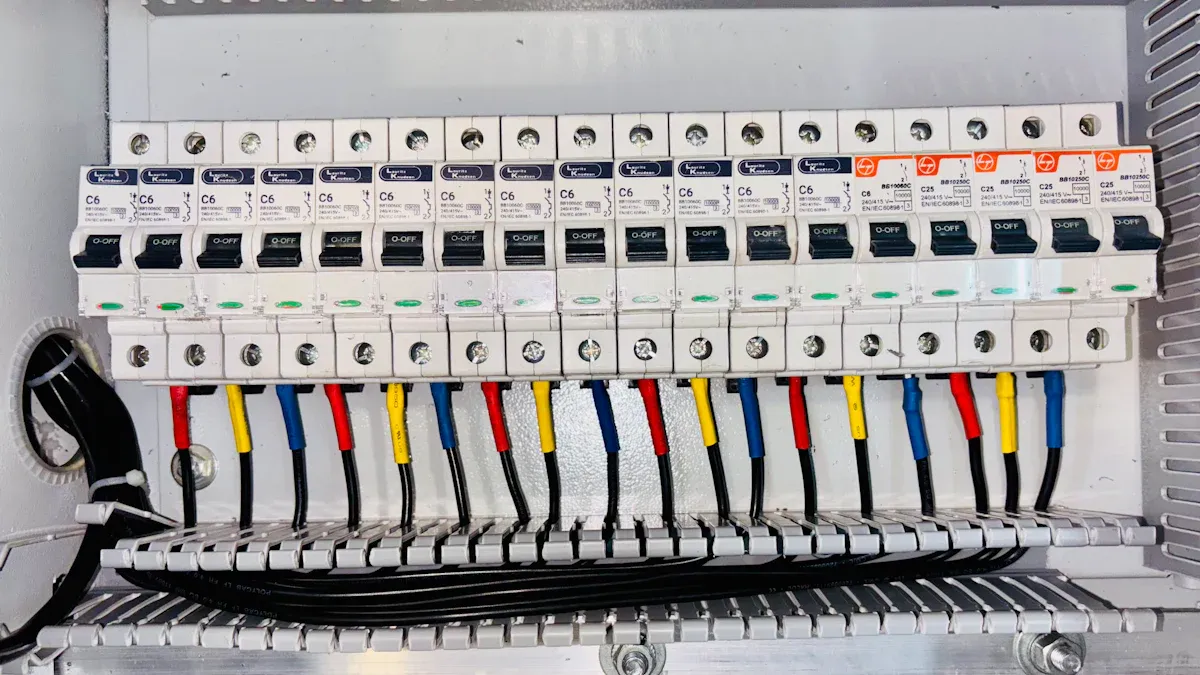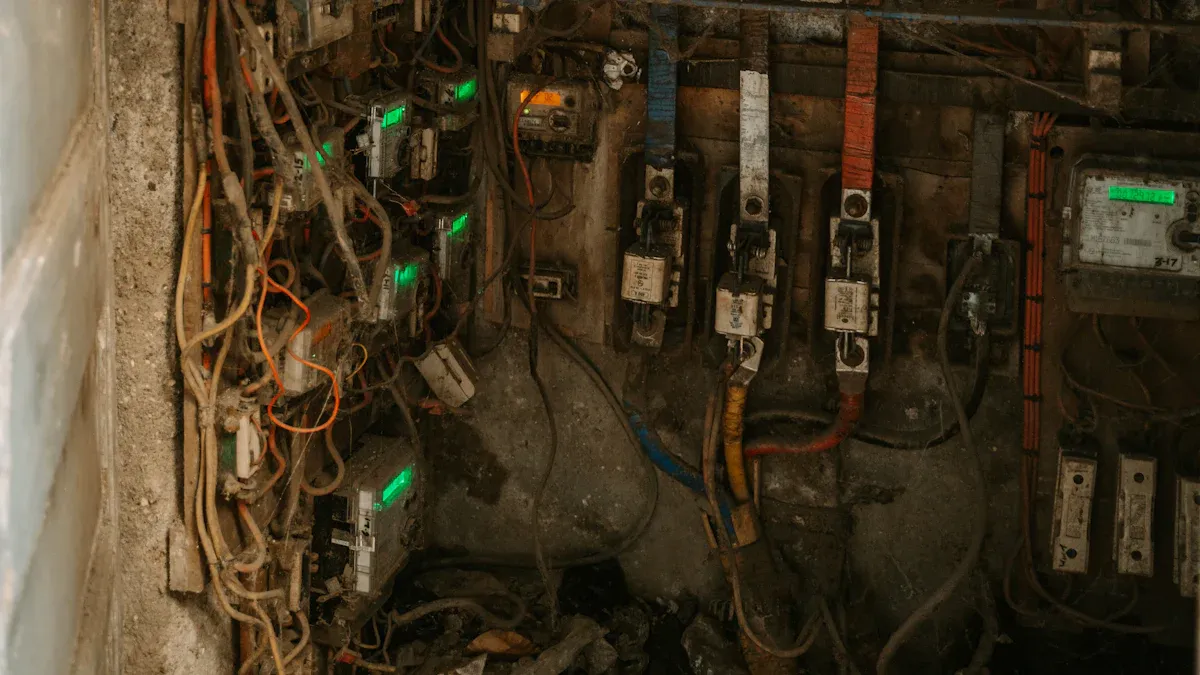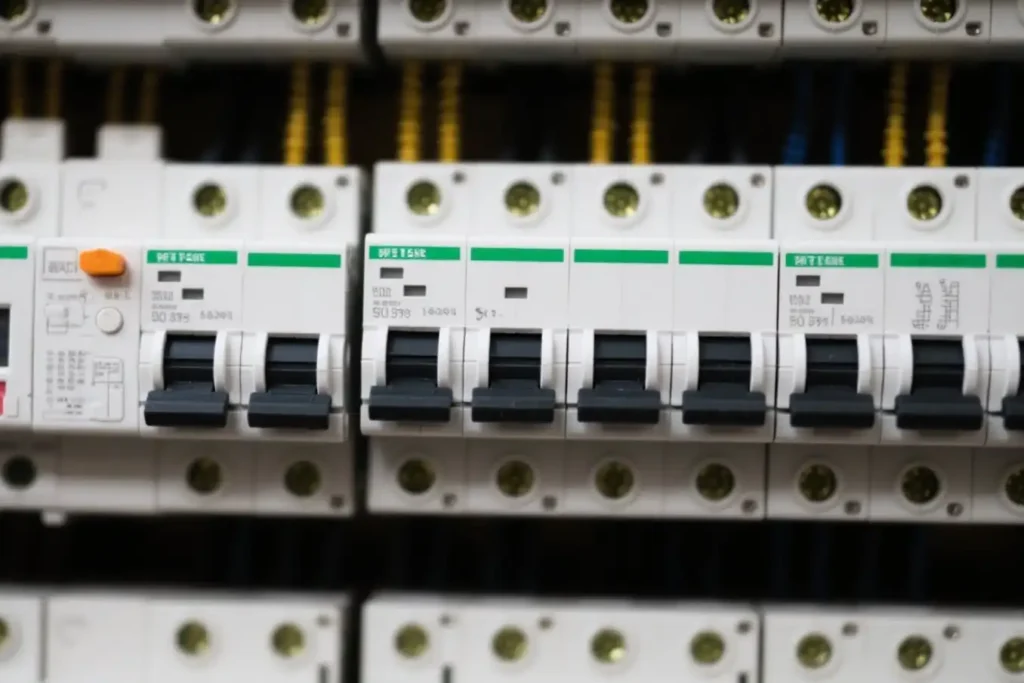Your home’s safety depends on knowing when a distribution board is overloaded. You might notice lights flickering or dimming when you turn on appliances. Breakers that trip often or warm outlet covers can also signal trouble. A buzzing noise or a burning smell from outlets means you need to act fast. You can learn simple steps to spot these issues and protect your home from electrical hazards.
Key Takeaways
- Look for warning signs like lights that flicker, breakers that trip a lot, warm outlets, buzzing noises, or burning smells. These can help you find an overloaded distribution board early.
- Follow the 80% rule. Keep your total electrical load under 80% of your main breaker’s rating. This helps stop overheating and fire dangers.
- Check your panel often. Test breakers once a year. Have a professional check it every 3 to 5 years to keep things safe.
- Do not make mistakes like adding breaker ratings wrong, using the wrong wire size, or missing hidden loads. These mistakes can cause overloads that are dangerous.
- If you see serious signs or have problems often, unplug devices. Reset breakers with care. Call a licensed electrician to keep your home safe.
How to Check if a Distribution Board Is Full

Checking if a distribution board is full helps you avoid electrical hazards and keep your home safe. You can follow these steps to understand your panel’s limits and prevent overload.
Find the Main Breaker Rating
Start by locating the main breaker in your panel. The main breaker acts as the master switch for your home’s electricity. It controls all the power that enters your house and protects your wiring from too much current.
- Look for the main breaker at the top or bottom of the panel, or sometimes next to the electric meter.
- The rating is usually stamped on the breaker handle. Most homes have a main breaker rated between 100 and 200 amps.
- The main breaker connects to two large bus bars that send power to all the smaller circuit breakers.
- Make sure the main breaker is easy to reach and not blocked by anything.
Tip: The main breaker’s rating must match the size of the wires coming into your home. This helps prevent overheating and fire risks.
Calculate Total Load
Next, you need to figure out how much electricity your home uses. This step helps you see if you are close to the panel’s limit.
- List all the circuits in your panel. Each breaker should have a label showing what it powers.
- For each circuit, check the appliances or devices connected. Find the power rating on the label or in the manual.
- Add up the wattage for all devices on each circuit.
- To get the total load, add the wattage from all circuits together.
- Divide the total wattage by your home’s voltage (usually 120 or 240 volts) to get the total amps.
For example, if your total wattage is 9,600 watts and your home uses 240 volts:
Total Amps = Total Watts ÷ Voltage
Total Amps = 9,600 ÷ 240 = 40 amps
Note: For a distribution board in a home, you can estimate the load by adding up lighting, outlets, and major appliances. If you plan to add a new appliance, check if your panel can handle the extra load.
If you want a more accurate result, you can use a clamp meter to measure the current on each circuit. Electricians often use special tools or software to do a full load study, especially in larger or more complex systems.
Use the 80% Rule
You should never load a distribution board to its full rated capacity for long periods. The 80% rule helps keep your system safe.
- Find the main breaker’s amp rating.
- Multiply this number by 0.8 (80%) to get the safe continuous load.
- Make sure your total calculated load does not go over this number.
For example, if your main breaker is rated at 100 amps:
Safe Continuous Load = 100 amps × 0.8 = 80 amps
Why is this important?
Breakers and wires can overheat if you use them at full capacity for hours. The 80% rule follows safety codes and helps prevent fires. In the United States, electrical codes require you to size wires and breakers for 125% of the expected continuous load, which means you should only use up to 80% of the breaker’s rating for loads that last three hours or more.
| Main Breaker Size (Amps) | Maximum Safe Continuous Load (Amps) |
|---|---|
| 100 | 80 |
| 150 | 120 |
| 200 | 160 |
Remember: If your total load is close to or above the 80% mark, you should not add more circuits or appliances. Call a licensed electrician for a full load study or amp test if you are unsure.
Regular checks help you spot problems early. Test your breakers once a year by flipping them off and on. Have a professional inspect your panel every 3 to 5 years, or sooner if you notice warning signs like tripping breakers or flickering lights.
Warning Signs of a Distribution Board Overload

Knowing the warning signs of an overloaded distribution board helps you protect your home and family. You can spot problems early by watching for these common symptoms.
Frequent Breaker Trips
If your circuit breakers trip often, this is a strong sign of trouble. Breakers are designed to shut off power when a circuit draws too much electricity. When you reset a breaker and it trips again, you may have an overloaded circuit, a short circuit, or a ground fault. Sometimes, old or damaged breakers trip even without a real problem. You can check for overloads by unplugging devices and plugging them back in one at a time. If the breaker trips with a certain device, that device or circuit may be the cause.
Tip: Write down when and where breakers trip. This helps you and your electrician find the cause faster.
Flickering Lights and Power Loss
Flickering or dimming lights often mean a distribution board is struggling with too much load. You may notice lights blink when you turn on appliances. Sometimes, appliances lose power or shut off without warning. These symptoms show that the circuit cannot handle the demand. You might also see warm or discolored outlets, or hear buzzing from switches.
- Flickering, blinking, or dimming lights
- Appliances losing power or shutting down
- Warm or discolored outlets and switches
- Buzzing or crackling sounds
Note: Power loss in specific circuits happens because the breaker trips to prevent overheating and fire.
Heat, Noise, or Burning Smell
Heat, strange noises, or burning smells from a distribution board are serious warning signs. Overheating can melt insulation and cause fires. You might feel warmth or hotness on the panel, see scorch marks, or smell burning plastic. Loud noises like buzzing, crackling, or popping can mean loose wires or failing parts. If you notice any of these, act quickly.
- Burning or unusual smells from outlets or the panel
- Warm or hot circuit breakers or panels
- Scorch marks or discoloration
- Buzzing, crackling, or popping sounds
⚠️ Warning: If you smell burning or feel heat, turn off power and call a licensed electrician right away. Do not ignore these signs. Quick action can prevent fires and keep your home safe.
Common Mistakes When Assessing a Distribution Board
Adding Breaker Ratings Incorrectly
A lot of people make mistakes when checking breaker ratings. Some think adding up the numbers on each breaker is enough. This way can cause big mistakes and be unsafe. Here are some mistakes you should not make:
- Using the wrong wire size for the breaker amperage. For example, a thin wire with a high-amp breaker can get too hot and start a fire.
- Adding up breaker ratings but not checking the real load on each circuit. You should keep your usage under 80% of the panel’s rated amps.
- Not grounding things the right way. If you put many neutral or ground wires in one spot, you might get loose connections and arcing.
- Bad labeling and messy circuits. This makes it hard to know which breaker does what, so you get confused and make mistakes.
- Not protecting wire insulation from sharp edges in the panel. If the insulation gets damaged, you can have electrical faults.
- Putting more than one wire into a single bus bar terminal. This can make loose connections and sparks.
- Skipping regular checks and not labeling circuits. This makes future checks harder and less safe.
Tip: Always use the right wire gauge for the breaker size. For example, use 14-gauge wire for 15-amp breakers and 12-gauge wire for 20-amp breakers.
Ignoring Hidden Loads
You might miss hidden loads when you check a distribution board. These hidden things can push your panel past its safe limit without you knowing. Watch out for these problems:
- Faulty wiring and loose connections. These can cause power loss and fire dangers.
- Circuits that are overloaded but do not trip right away. These still put stress on the panel.
- Not doing regular checks. Corrosion or rust can hurt connections over time.
- Using high-wattage appliances at the same time on one circuit. This can overload the system fast.
- Bad or missing circuit labels. Without clear labels, you cannot spot overloaded circuits easily.
- Old wiring or panels that do not meet today’s safety rules.
- New appliances like EV chargers, heat pumps, or kitchen upgrades. These add more demand than old panels can handle.
- Modern devices and smart home tech. These can raise the total load, sometimes without you noticing.
- Uneven loads. If one phase has more current, it can get too hot and cause imbalance.
- Harmonics from electronics. These can secretly raise current in some wires and cause voltage drops.
⚡ Note: If you see breakers trip a lot, lights dim, or feel heat from the panel, you might have hidden overloads. Do regular checks to find these problems early.
What to Do if a Distribution Board Is Overloaded
Immediate Safety Steps
If you suspect a distribution board is overloaded, you need to act quickly to keep your home safe. Follow these steps to reduce risk and find the cause:
- Unplug all appliances and devices from the affected circuit. This lowers the load and helps you find the problem.
- Turn off the breaker at the main panel before you work on the circuit. This step keeps you safe from electric shock.
- Let the circuit cool down for a few minutes. Overheated wires need time to return to a safe temperature.
- Reset the tripped breaker by switching it off and then back on.
- Reconnect your devices one at a time. Watch to see if a certain appliance causes the breaker to trip again.
- If you find one device causing the problem, keep it unplugged and use another outlet on a different circuit.
- Always keep the total load below 80% of the breaker’s rated capacity. For example, on a 15-amp breaker, do not use more than 12 amps for long periods.
- If you notice burning smells, buzzing sounds, or the breaker trips again right away, stop and call a licensed electrician.
⚠️ Tip: Never ignore warning signs like heat, noise, or burning odors from a distribution board. Quick action can prevent fires and protect your family.
When to Call an Electrician
Some problems need a professional. You should call a licensed electrician if you notice any of these signs:
- Flickering or dimming lights in your home.
- Frequent tripping of circuit breakers or blown fuses.
- Warm or discolored wall plates or outlets.
- Buzzing, sizzling, or cracking sounds from outlets or the panel.
- Burning odors near switches or outlets.
- Mild shocks when you touch appliances or switches.
- Outdated wiring or an old electrical panel.
- You plan to add new high-power devices or outlets.
A licensed electrician can check a distribution board, find hidden problems, and make repairs that follow safety codes. Always check that your electrician has a valid license, insurance, and good reviews from other customers. This ensures your home stays safe and your electrical system works as it should.
You can keep your home safe by following a few simple steps. Watch for warning signs like tripped breakers, flickering lights, or burning smells. Turn off high-use appliances and check your panel for tripped breakers. Test each device one at a time and label your circuits. Schedule inspections every 3 to 5 years, or sooner if you notice problems. If you see any danger signs, contact a licensed electrician right away.
FAQ
How often should you check your distribution board?
You should check your distribution board at least once a year. Look for signs like tripped breakers, flickering lights, or burning smells. Schedule a professional inspection every 3 to 5 years for extra safety.
Can you add more breakers if your panel looks full?
You should not add more breakers if your panel looks full. Overloading the panel can cause safety risks. Always ask a licensed electrician before making changes.
What should you do if a breaker keeps tripping?
Unplug all devices on that circuit. Reset the breaker. Plug in each device one at a time. If the breaker trips again, stop using that circuit and call an electrician.
Is it safe to reset a tripped breaker yourself?
Yes, you can reset a tripped breaker yourself. Make sure your hands are dry. Stand on a dry surface. If the breaker trips again right away, call a licensed electrician.
What is the best way to label your circuits?
Use clear, simple labels for each breaker. Write what each breaker controls, like “kitchen outlets” or “living room lights.” This helps you find problems faster and keeps your home safer.
The following information may be of interest to you
How to choose the size of the distribution board
Distribution Box Industry Comparison of Types and Uses
Electric motor circuit breaker selection and usage
What Is a Fused Distribution Box and How Does It Work
How a Distribution Board Works and Why It Matters



